Introduction:
Undoubtedly, technology has caused a massive change in the sports industry. Players’ performance, advanced analytics, and movements of players are some major things that users track as well as analyze in sports. Modern wearable technology in sports has made such data available readily to users and teams. Wearable devices can easily integrate into different things, allowing teams to effectively track necessary data. These devices can be fitness trackers, smartwatches, etc.
Do you want to learn more about this amazing technology? In this blog, you will explore the remarkable journey of wearable technology and how it has influenced the world of sports.
What Do You Mean by Wearable Technologies?
In simple words, wearable technologies or wearables are modern electronic devices that we wear physically to track, transmit, and analyze personal data. From sleep patterns to movements to heart rate, these devices can track several aspects of the human body.
In the case of sports, athletes, and coaches can easily accumulate different types of readings to detect weaknesses and train smarter. These devices collect data in real-time and offer nearly accurate information. Some examples of wearables are fitness trackers, smartwatches, smart rings, and more.
Wearable Technology In eSports Statistics
Immerse yourself into a fascinating world of wearables with these important statistics.
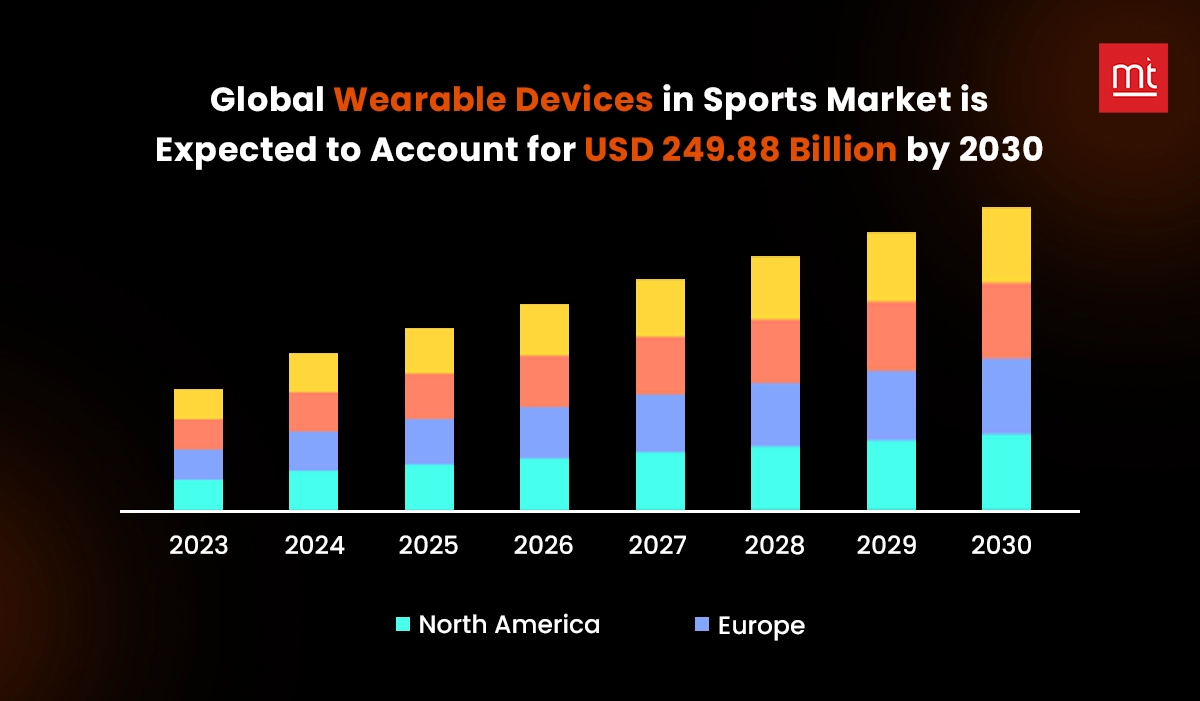
- As per a report, the wearables in the eSports market are projected to grow at a Compound Annual Growth Rate of 13.5 percent from 2023 to 2030. It may also cross the USD 249.8 billion mark by the end of 2030.
- By 2027, around 640 million wearables are projected to be shipped across the world.
- The AR glass segment is forecasted to grow by USD 13.4 billion between 2020 to 2024.
- A study conducted by the American College of Sports Medicine informed that athletes who used wearable tech in sports demonstrated around 22 percent improvement in their performance.
Different Types of Wearable Technologies
Wearable technologies can take different shapes, for example:
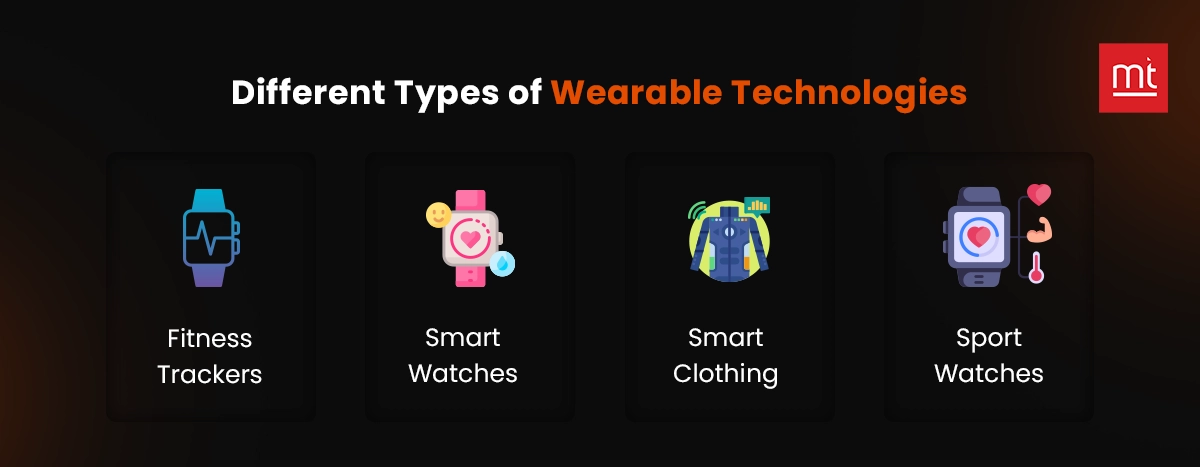
1. Fitness Trackers
These devices are effective in tracking steps and heart rate. Using these, you can get accurate data on the total amount of calories burned.
2. Smart Watches
These are more than just showing time. They can offer instant notifications on your emails, messages, calls, and more. Some also allow you to track distance covered, sleep, calories burned, and more.
3. Smart Clothing
These are clothes with different electronic devices that can measure respiration rate, body temperature, heart rate, sleep, etc.
4. Sport Watches
These devices are designed for athletes who love swimming, cycling, and running. These are good at recording users’ heart rate, pace, fatigue limit, and more.
Real-Life Examples of Wearable Technology in Sports
Many wearables come equipped with magnetometers, gyroscopes, accelerometers, etc., that help coaches and athletes know how they move and about the forces produced by them during activities.
While individual athletes utilize sports wearable technology for improvement and performance monitoring, sports clubs use wearables for creating training strategies and for decision-making. Let’s understand this with some examples.
1. Converting Heartbeat Records into Important Insights
Firstbeat has introduced an amazing athletic monitoring solution to optimize recovery and training while enhancing performance. It can be used by both athletes and sports clubs. The device comes with a sensor that tracks HRV- Heart Rate Variability data, recovery data, and training load.
Then the device’s advanced algorithms analyze the data and display the results in the app. Using HRV-based insights, sportsmen and coaches can come up with data-driven decisions. Today, more than 1000 teams and 23,000 athletes use Firstbeat sports.
2. Tracking and Evaluating Swimming Activities
FORM, a reputed sports technology firm has developed Smart Swim Goggles that can track swimming progress quite effectively. These goggles have an augmented reality display and motion sensors. When you start swimming, the goggles will automatically start recording strokes.
On the display, you can check instructions for better workouts and important metrics, such as calories burned, distance, speed, pace, session duration, and more. The data can be shared with Final Surge, Apple Health, Strava, or TriDot. Some popular athletes like Gustav Iden, Kristian Blummenfelt, Aaron Royle, and Skye Moench are using these goggles during their training as well as competitions.
Benefits of Using Wearable Technology in Sports
From amateurs to professionals, wearables are changing the game for all. A wearable, created by the best wearable app development company can offer numerous benefits.
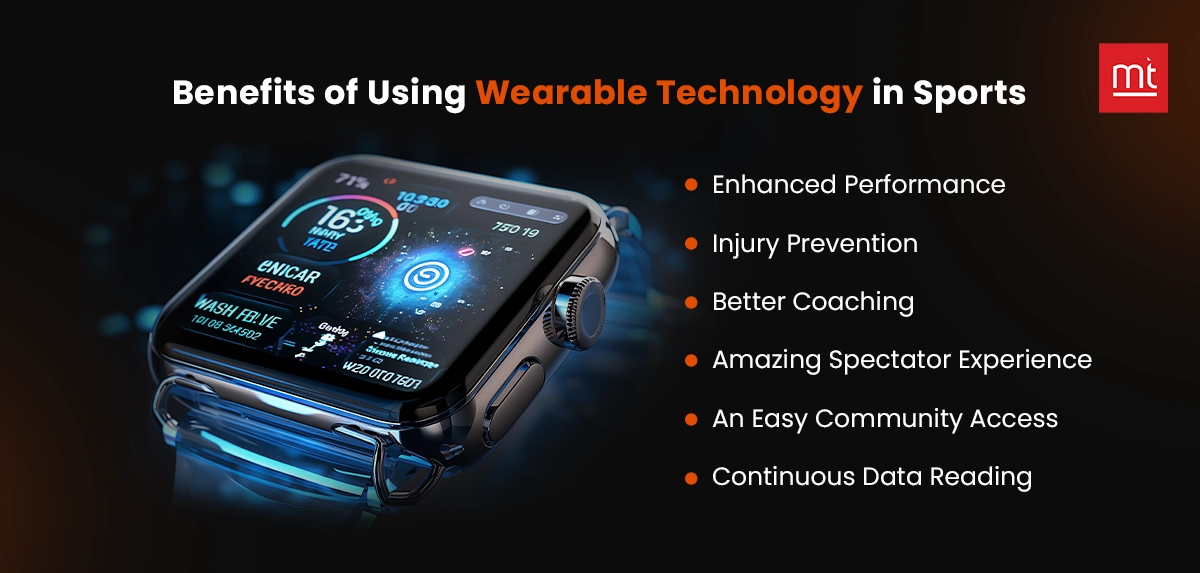
#1. Enhanced Performance
Wearables don't just offer athletes a boost to improve their performance. They offer a huge amount of important data that one can analyze and use to create a better training plan that can help enhance overall performance.
#2. Injury Prevention
Medical staff and coaches can detect irregularities in movements that can cause injuries. Based on the data they can adjust training regimens to effectively address any possible risks quickly. This also helps avoid training overload issues.
#3. Better Coaching
Wearable technology can also help coaches. They can use these technologies to create some advanced yet safe training programs. Wearables can also help them offer a more personalized coaching experience.
#4. Amazing Spectator Experience
Wearables are also beneficial for fans. For example, VR headsets can take viewers directly into the arena, offering an interactive and immersive experience. Sports lovers can experience actions from different angles.
#5. An Easy Community Access
Apps connected with wearable devices can allow users to easily connect with multiple users. One can find other users near them to do training together. They can also compare their metrics. Besides, some wearables help bridge the gap between players and fans, creating a sense of shared excitement.
#6. Continuous Data Reading
Wearables can help athletes read data that was not available previously. For instance, they can now receive updated data of their entire training sessions with a few simple clicks and there is no need to watch a lengthy video to get the data.
Positive and Negative Effects of Wearables in Sports
Apart from the above-listed benefits, wearables have some other positives that are truly remarkable. Let’s take a look.
Pros of Wearables in Sports:
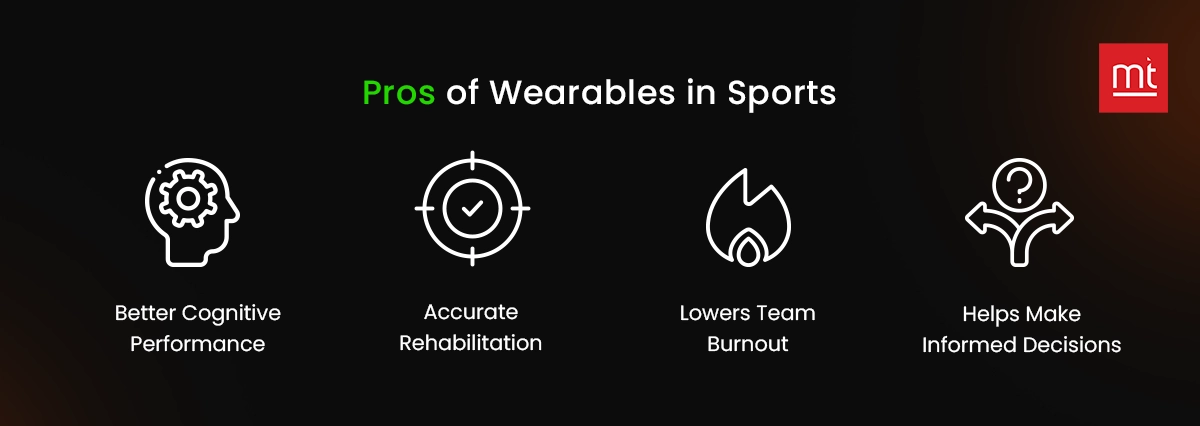
- Better Cognitive Performance: Wearables can help athletes to effectively monitor their cognitive performance. These technologies can measure decision-making speed, reaction time, mental stamina, etc., offering crucial insights for teams and individuals.
- Accurate Rehabilitation: Some wearables can accurately monitor as well as guide various rehabilitation exercises. This, in turn, can lower the chances of re-injury.
- Lowers Team Burnout: Wearable technology lets teams collect data on athletes’ fatigue and stress levels. By detecting the early symptoms of burnout, it is possible to come up with a personalized training strategy and rest duration to maintain their performance levels.
- Helps Make Informed Decisions: Coaches and players can now come up with informed decisions by analyzing data recorded by these devices. They both can expect better competition and quality games.
Cons of Wearables in Sports:

- Financial Investment: Hiring the best app development services in the USA requires huge financial resources. For accurate results, a team needs to invest in the latest software and hardware solutions along with regular updates and maintenance.
- Data Security: All wearables collect various types of personal data and can raise data privacy concerns. It is important to check the security features offered by the device before using it.
- Overemphasis on Performance Metrics: Some experts say focusing always on metrics can make users ignore sports’ qualitative aspects, like intuition and technique. This can affect the real magic of professional sports.
Even though there are some disadvantages, these can be avoided by optimizing wearables with the help of new technologies.
How Are Wearables Changing Today’s Sports Industry?
The sports industry has benefited more from modern wearable technologies, compared to other industries. These have not just helped athletes improve their training but also have changed the entire industry. Wearables provide users with valuable real-time insights related to physical metrics, enhancing overall performance.
These devices have expanded to different types of sports, helping coaches and players make informed decisions. Some devices such as GPS-enabled vests have greatly revolutionized training by offering accurate data on speed, movement, as well as workload.
On the other hand, powered by AI, some wearables have become a game-changer in detecting possible risks and avoiding injuries by tracking and analyzing performance data. Such data can be utilized by sports clubs or coaches to make major in-game decisions. For instance, if a team sees that a particular player traveled a lot, they can consider replacing that player.
Wearable technologies have helped users to detect indications of soft tissue damage quickly. Most coaches use them to customize training programs for players. Possible brain trauma, concussions, torn muscles, and overexertion can be easily identified using impact monitor stickers. These technologies can make teams more competitive, prepared, and skilled. Besides, it has also opened up multiple exciting avenues for fitness-conscious people, athletes, and enthusiasts.
Top Companies Offering Wearables
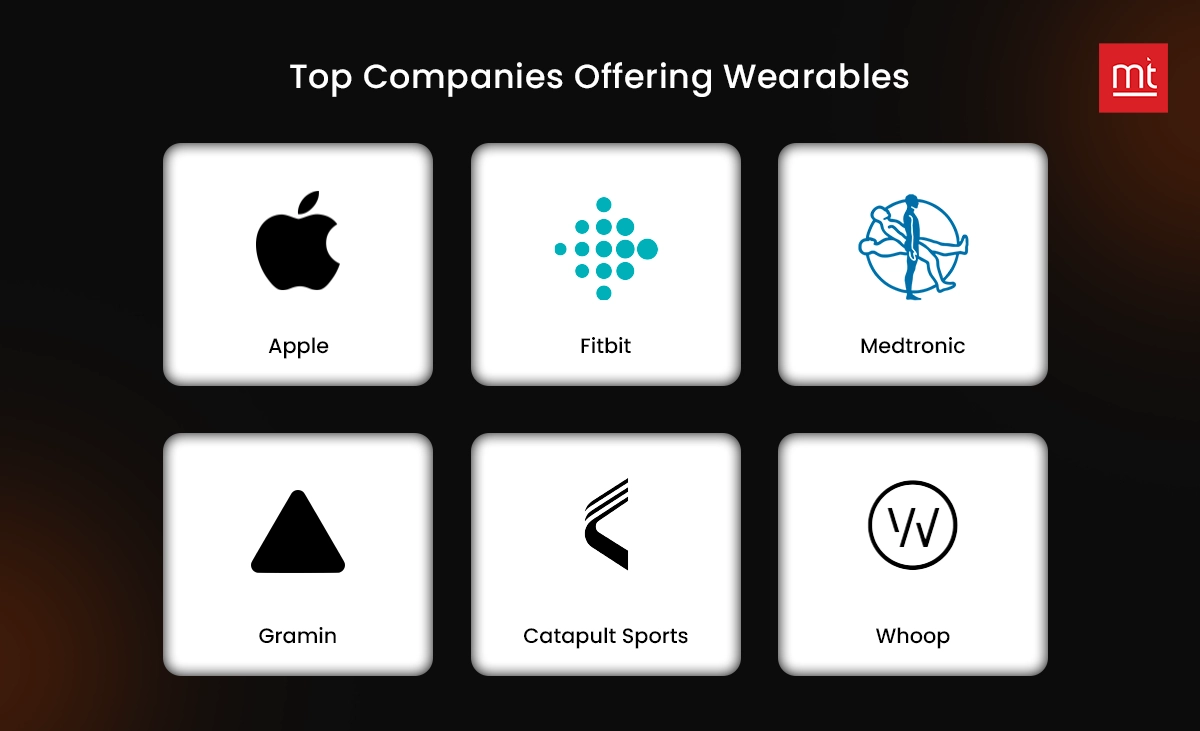
1. Apple
The company’s Apple Watch is an innovative smartwatch that comes with sophisticated fitness tracking features. Besides, the watch also supports ECG monitoring. Both regular consumers and fitness enthusiasts love using Apple Watches.
2. Fitbit
This brand is well-known for providing consumers with a wide range of smartwatches and fitness trackers. These devices are quite effective in monitoring multiple health metrics, like sleep patterns, heart rate, etc.
3. Medtronic
This prominent healthcare technology brand is popular for its innovative wearable devices. For example, their wearable glucose monitors can offer real-time data to users and doctors. Powered by the Guardian Sensor 3, it can notify users around 60 minutes earlier about low or high glucose excursions.
4. Gramin
Garmin has already introduced many sports watches and fitness trackers that come with advanced features. They have different devices for running, diving, swimming, golf, and outdoor activities.
5. Catapult Sports
This brand produces wearable products designed specifically for athletes and sports teams. They offer wearable solutions for football, rugby, basketball, cricket, baseball, volleyball and more. Their solutions can track players' movements, performance, run-up distance, speed, injuries, recovery, and more.
6. Whoop
Whoop’s fitness trackers offer 99 percent accurate HRV and heart rate tracking. Besides, the devices can be used for sleep tracking. They measure the metrics that are scientifically proven to have a major impact on athletes’ mental and physical health.
If you are planning to develop wearable apps or devices and searching for some best web app ideas, you can consider these brand’s products as an example. Remember that the primary focus should be fulfilling the needs of fitness enthusiasts and elite athletes.
What Is the Future of Wearable Technology in Sports?
Wearable technologies are becoming a crucial and prevalent element in the world of sports. The devices are getting more efficient and powerful as the brands are now focusing more on integrating human elements. That means, in the future, you can expect to see some devices with better IoT and data analysis capabilities.
We are living in a world where focus on well-being, personalization, and integration of sports analytics take center stage. These devices are projected to bring some major changes in how athletes compete, train, and recover.
However, wearable technology is also facing some critical challenges such as poor battery technology, electronic waste, device fatigue, personal data security, and more. But these things can be eliminated.
For now, we can say that the future of wearables is quite promising. The next major thing in this field is not just a device, it is a massive shift towards a bright future where users will have the power to understand and unlock their maximum potential. We think the only limit will be our imagination.
Conclusion
Wearable technologies in the world of sports have boosted the development of the sports industry as well as individual sportspersons. This technology is helping users from monitoring heart rate to forecasting the risk of tissue damage. As more people have now started using wearables, you can also take advantage of this, and hire remote developers from India to introduce your wearable app. Also, you can connect with expert companies like Manektech to develop your wearable apps.
This is a perfect time to join the growing sports tech industry!
About Author
Subscribe to Our Newsletter!
Join us to stay updated with our latest blog updates, marketing tips, service tips, trends, news and announcements!





















